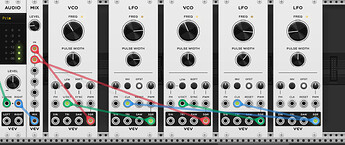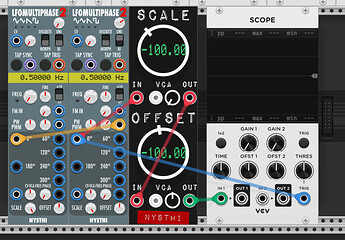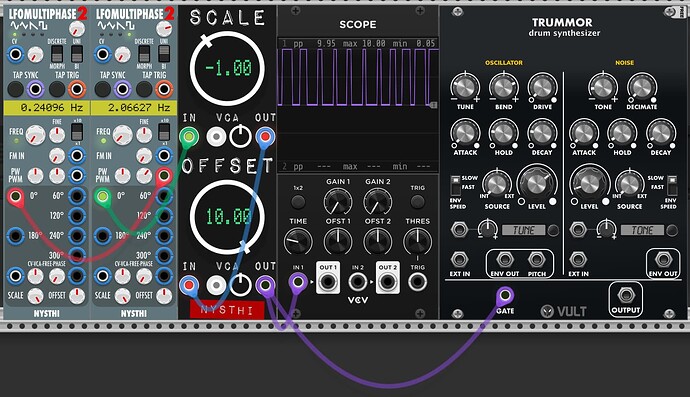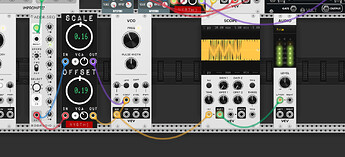Hit the “INV” button. That was the genius part.
Phase shifting a SAW and an INV SAW (mixed) wil give you PWM either way. But with shifting offset as well.
But as said. It’s the lead side of the pulse that counts (for trigger/gate signals).
Though…it’s also the signal level. And not all trigger/gate levels (thresholds) are equal. There can be pretty substantial differences in how much voltage is needed to trigger/gate a specific module.
And of course duration is also relevant. Too short or too late might not trigger at all. Too long might retrigger where no retrigger is expected/wanted.
EDIT: A COMPARATOR is another way to do PWM by modulating the COMPARATOR threshold
Either one sided ‘left’ or ‘right’ by feeding it an (INV) SAW or both sided using a TRIANGLE.
I’ve been using Analog Shift Registers to create a … I dunno what it’s properly called… a backbeat (?) event. Or syncopated? It’s different from “swing”, at any rate. Say you want a delayed open high-hat cymbal followed by a closed high-hat, then 5 more empty beats, as in: x-O-C-x-x-x-x-x.
CLK1 is set to /4, and is hooked up to the IN of ML Modules “Shift Register”.
CLK2 is set to X2 and is hooked up to the TRG of the Shift Register. This gives you a CLK1 pulse passing through 4 contiguous outputs of the 8 outputs at any given time.
For the above “x-O-C-x-x-x-x-x” example, hook up o/p 2 of the shift register to the open hi-hat and o/p 3 to the closed hi-hat. They do not re-trigger three more times as CLK1 steps through because it stays high. Have fun moving the the patch cords to different outputs or adding, say, a kick to the first output.
[a few minutes later] It just occurred to me that a simple sequencer like Bogaudio’s ADDR-SEQ would do much the same thing, but somehow the ASR seems like more fun. Maybe it gives more options for doing stuff like using Bernoulli gates on the input or outputs too.
Some trigger sequencer like one from @CountModula might be the most “straightforward” way to do something like that?
Yeah, but most of them take up a lot more real estate than the ASRs. Bit of an issue when working on a 13" display.
“I might use the Marbles to modulate the clock”
Is like; you can watch a second favourite movie this saturday.
Here is mine, with the non working PWs, something happens when i turn them, but they are not in some kind of “auto-sync”. They are currently behaving like 2 vinyl machines where you have to fiddle in the rythm with them.
What I was hoping was for the LFO on the right side to send a pulse to the other two that sync them, but it instead gives a kind of one way offset, where it can only speed up the other two, but not down. I will try again with other LFOS as was written in the thread.
Yes. Be advised that Meander is a very complex module with approximately 80 parameter knobs and parameter CV control inputs. It is definitely not a beginner’s module when it comes to parameter control. It is a beginner’s module when it comes to generative harmony, melody and bass parts according the the circle-of-fifths of music theory and practice.
I am glad to see it has a notation interface, It will be an adventure to explore it =)
Here is an easy way of getting the effect described above, A kind of “Groove Clock”:
groove clock.vcvs (6.9 KB)Clocked clock is inverted and delayed by the same amount (in this case X4 is and delayed by 1/8) to avoid glitches.
Use the Addr-Seq to move the beat backwards (negative) or forwards (positive) in time.
Add expanders to Addr-seq for a longer sequence, or replace it with a random/sample and hold module set to ±5V for a wonky beat.
Another trick is to fade between the sequence and a constant 0V, to gradually go from a straight beat to a more groovey or random one.
In the selection above I’ve only modified the first clock and left the second one as is for reference.
Downloading ![]()
Auretvh there is a problem now, and that problem is I have so much fun playing with everything I got in VCV rack already so when its time to do some training, I open a patch and there goes a couple hours of playing. ![]()
![]()
![]()
Where does the purple cable come from? Also i dont understand how a cable can go inside the offset output and out again in to scope. Here is my version
It can’t, its an output port so it’s GOING somewhere…
PS in stead of using the scale/offset module, you could use the 180deg out it has (in this case) the same outcome
With the Scale/Offset It was always for me that one was working and the other one wasnt. Now with this experiment finally both are behaving mannerly:
Since those are spaceship LFOs I will retreat to regain my strenghts and powers before I deal with them yet again. ![]()
Is it to be expected like this here (at 2:16)
(411) Jam Jam - 4-channel multimode trigger and gate processor from Noise Engineering - YouTube
Funkyness start at (2:49)
Hello,
I am writing from the infirmary since I am still bleeding from several vital organs, I cannot return for battle today. However I will regain strength more quickly by writing letters to family and friends. ![]() I ask for clemency by reason of breaking forum etiquette for sending this letter off topic ;
I ask for clemency by reason of breaking forum etiquette for sending this letter off topic ;
The Nysthi Scale, is it possible to utilize it in some capacity so that it only transpose the highest or preferably the two highest pitches? Would be so useful as I have noticed there is always the highest pitch that will be in dissonance with whatever else is going on.
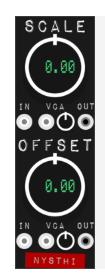
If you are working with poly pitch info in VCV, you can split it into discreet channels/cables and run multiple offset ( one for each channel) and have per voice offset. Merge and along you go.
I did not use poly yet in VCV. Would it be possible to split with a comparator instead?

